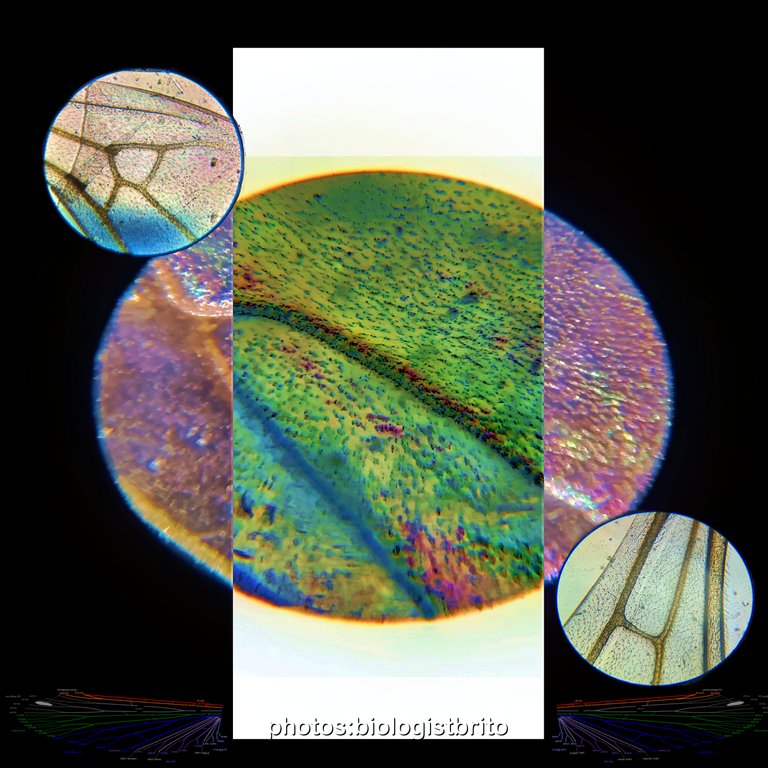Hello dear community, did you know that in multicellular living organisms insects are the most abundant on the planet? In total we could add more than a million species and Biologists think that there are hundreds of them yet to be discovered! then such a biodiverse and abundant group must undoubtedly fulfill an important role in nature thanks to them the ecosystems have "maintenance and sustenance". Insects can eat many types of food but practice the habit: (phytophagous) is their favorite this means they eat some part of the plant structure! Join me in this post to learn a little about insects and deepen the study of their wings.🧠🔬🥼
Hola querida comunidad, sabias que en los organismos vivos multicelulares los insectos son los mas abundantes del planeta? en total podriamos sumar mas de un millon de especie y los Biologos piensan que hay cientos de ellos aun por descubrir! entonces un grupo tan biodiverso y abundante sin duda debe cumplir un roll importante en la naturaleza gracias a ellos los ecosistemas tienen "manutencion y sustento". Los insectos pueden comer muchos tipos de alimento pero practicar el habito: (fitofago) es su favorito esto quiere decir comen alguna parte de la estructura de la planta! acompaname en este post para aprender un poco sobre insectos y profundizar el estudio de sus alas.🐝🧫🕵️♂️🥽
Insects with two wings are diptera and are quite abundant to date about 130 families have been described, few have read about the nematocera they are known as "lower diptera", within this category are grouped insects that have long and thin legs, their antennae are known to present a multifragmentation characteristic! These lower diptera are more than 52 thousand species, here we include the mosquitoes that are from the Culicidae family, and I mention it because one of the wings that we will see in the post is from a mosquito! We start with our experience and the first thing we notice is the membrane that covers the wing of an insect. It is membranous and thin, in addition to being a little elastic and not very rigid, it is designed to withstand a lot of friction.🧫🕵️♂️🐝
Los insectos con dos alas son dipteros y son bastantes abundantes hasta la fecha se han descrito unas 130 familias, pocos han leido sobre los nematocera son conocidos como "dipteros inferiores", dentro de esta categoria se agrupan los insectos que tienen patas largas y finas, sus antenas son conocidas por presentar una caracteristica de multifragmentacion! estos dipteros inferiores son mas de 52mil especies, aqui incluimos los zancudos que son de la familia culicidae, y lo menciono porque una de las alas que veremos en el post es de un zancudo! comenzamos con nuestra experiencia y lo primero que notamos es la membrana que cubre el ala de un insecto es membranosa y fina ademas de ser un poco elastica y poca rigidez, esta disenada para soportar mucha friccion.🥽🔬🧠
Insects, like birds, have been a source of inspiration for human beings since our civilization wanted to take to the skies, insect flight is very efficient, it is usually fast, maneuverable and quite versatile depending on the species, all this thanks to the mechanism and wing structure. There are two types of flight, direct and indirect, insects with less advanced flights have an "indirect" flight, the muscles are: "dorsal and tergosternal", then the muscles in the wings are also divided into: "direct and inferior axillary basal (Wikipedia)"🕵️♂️🥽
Los insectos al igual que las aves han sido fuente de inspiracion para el ser humano desde que nuestra civilizacion quiso surcar los cielos, el vuelo en los insectos es muy eficiente suele ser rapido, maniobrable y bastante versartil dependiedo la especie, todo esto gracias al mecanismo y estructura de las alas. Existen dos tipos de vuelo el directo e indirecto los insectos con vuelos menos avanzados tienen un vuelo "indirecto", los musculos son: "dorsal y el tergoesternal", luego los musculos en las alas tambien se dividen en: "basal axilar directa e inferior (wikipedia)"🧠


there are two integuments that give the structure to the wing and that are "juxtaposed", for the formation of the vein the layers of the integument are not joined together and the cuticle, which is the outermost layer in arthropods, becomes very thick! We can be Biologically that it is very sclerotic, that is, little evolved. The wings in insects are formed from: "paranotal lobes", in the case of aquatic species the wings are modifications of the "mobile gills".🔬🧠
existen dos tegumentos que le dan la estructura al ala y que estan "yuxtapuestos", para la formacion de la vena las capas del tegumento no estan unidas entre si y la cuticula que es la capa mas externa en los artropodos se torna muy gruesa! podemos ser Biologicamente que esta muy esclerotizada osea poco evolucionada. Las alas en los insectos se forman de: "los lobulos paranotales", en el caso de especies acuaticas las alas son modificaciones de las "branqueas moviles". 🧫🐝


Insect wings not only have one vein but also several main veins, as you can see in the photo, in each vein there is a nerve and a trachea that functions as a small conduit, it is known that the hemocoel is linked to this vein for what that consequently the "blood": (hemolymph) manages to irrigate the wings of the animal.🧠🧫🐝
las alas de los insectos no solo tiene una vena si no varias venas principales, como puedes ver en la foto en cada vena hay un nervio y una traquea que funciona como un pequeno conducto, se conoce que el hemocele esta ligado con esta vena por lo que a consecuencia la "sangre": (hemolinfa) consigue irrigar las alas del animal.🕵️♂️🥽🩸🩸

Microtrichia and Macrotrichia🐝🔬🧠/ Microtriquios y Macrotriquios🕵️♂️🧫

surely you came to see insects with "hairs" normally we see flies with hairs on their legs and body, but did you also know that there are "hairs" on the wings of insects? First let me clarify that they are not hairs... They are external structures called Macrotrichia and Microtrichia that are defined as appendages of the cuticle of insects, they have various functions from protection to sensitivity depending on the species. In butterflies the macrotrichia are modified and look like feathers!🥽🕵️♂️🐝
seguramente llegastes a ver insectos con "pelos" normalmente vemos las moscas con pelos en sus patas y cuerpo, pero sabias tambien que existen "pelos" en las alas de los insectos? primero dejame aclararte que no son pelos... Son estructuras externas llamadas Macrotriquios y Microtriquios que se definen como apendices de la cuticula de los insectos, tienen varias funciones desde proteccion hasta sensibilidad dependiendo la especie. En las mariposas los macrotriquios son modificados y parecen plumas! 🧠🔬🥼

Taxonomy in veins🐝🔬🧠/ Taxonomia en venas🕵️♂️🧫


There is a system called: (Comstock-Needham system) created in 1898 and to this day it is used to classify the families of insects by their veins, the wings have main veins and these extend throughout the elastic membrane in the form longitudinal, then there are other veins that join the longitudinal and are called transverse, when spaces between veins are called "cell."🧠🔬🥼
Existe un sistema llamado: ( sistema de Comstock–Needham) creado en 1898 y hasta el dia de hoy se utiliza para clasificar las familias de los insectos por sus venas, las alas tienen venas principales y estas se extienden por toda la membrana elastica en forma longitudinal, luego hay otras venas que se unen con las longitudinales y se llaman transversales, cuando se forman espacios entre venas se le denomina "celula".🕵️♂️🥽🧫

Sex and wings??🐝🔬🧠/ Sexo y alas??🕵️♂️🧫

You probably wondered like what sex and wings? Actually, there is a scientific work by: (Marcadal, Miranda, Wilke, Barcelo; 2021) they captured several specimens of mosquitoes in a laboratory work and discovered quite interesting data and it is possible to sex the animal based on the size of its wings, this due to the behavior of both, the male has slightly smaller wings due to its way of feeding it must look for nectar in the plants and its flight is less intense than the female, which instead must go to look for blood feeding for oogenesis and then placing the eggs in the water all this adaptation and evolution led to variations in the size of the wings.🧠🔬🥼
Probablemente te preguntaste como que sexo y alas? en realidad existe un trabajo cientifico de: (Marcadal, Miranda, Wilke, Barcelo; 2021) ellos en un trabajo de laboratorio capturaron varios ejemplares de mosquitos y descubrieron un dato bastante interesante y es posible sexar el animal en base al tamano de sus alas, esto por el comportamiento de ambos, el macho tiene las alas un poco mas pequenas por su forma de alimentacion debe buscar nectar en las plantas y su vuelo es menos intenso que la hembra que en cambio debe ir a buscar alimentarse de sangre para la ovogenesis y luego colocar los huevos en el agua todo esta adaptacion y evolucion llevo que existiese variaciones en el tamano de las alas.🔬🧠🧫
https://www.frontiersin.org/articles/10.3389/fevo.2021.569034/full

DNA is an organization to foster and DENSIFY NATURE-APPRECIATION which aims to establish REPORTS OF BIODIVERSITY DATA that is contributed by all of us Hiveans and subsequently cataloged.
Therefore DNA searches for HIGH-QUALITY posts that aim to DESCRIBE and determine the BIODIVERSITY AROUND YOU with added EXPLANATIONS and INFORMATION. For these informative posts they offer a CURATION SERVICE using the @dna.org account. It is also a CURATION TRAIL. Just add the #dna TAG if you think that any of your posts is what they are looking for.
THANKS FOR READING ME (PHOTOS OF MY PROPERTY) / GRACIAS POR LEERME FOTOS DE MI PROPIEDAD🙂🧠🦾👍
Referencias bibliograficas / Sources:
Bibliographic references: "" the explanation of the area was thanks to the information extracted from the internet, the appointments are mentioned in the place, other information from my intellect.


















Congratulations @biologistbrito! You have completed the following achievement on the Hive blockchain And have been rewarded with New badge(s)
Your next target is to reach 60 posts.
You can view your badges on your board and compare yourself to others in the Ranking
If you no longer want to receive notifications, reply to this comment with the word
STOPTo support your work, I also upvoted your post!
Check out our last posts:
Excelente compilación fotográfica sobre las alas de estos artrópodos, sin duda son una de las estructuras más interesantes que tienen estas formas de vida, a no ser que sean alguna especie áptera, entonces ahí habría que buscar otros aspectos interesantes jaja. Creo que una de las alas más interesantes las poseen los lepidópteros, pero más que todo por el papel que juegan sus setas modificadas u escamas, esto ya es algo que mencionaste muy bien en tu post referidos a las polillas de hace unos días atrás. He llegado a hacer mención de las alas de los insectos y su importancia en algunas de mis publicaciones, pero tus imágenes describen muy bien todo para cualquier interesado en el tema. Un abrazo amigo, saludos.
Un abrazo a ti también mi pana! Con los bichos siempre se descubre algo nuevo.
Thanks for your contribution to the STEMsocial community. Feel free to join us on discord to get to know the rest of us!
Please consider delegating to the @stemsocial account (85% of the curation rewards are returned).
You may also include @stemsocial as a beneficiary of the rewards of this post to get a stronger support.
¡Felicitaciones!
1. Invierte en el PROYECTO ENTROPÍA y recibe ganancias semanalmente. Entra aquí para más información.
3. Suscríbete a nuestra COMUNIDAD, apoya al trail de @Entropia y así podrás ganar recompensas de curación de forma automática. Entra aquí para más información sobre nuestro trail.
4. Creación de cuentas nuevas de Hive aquí.
5. Visita nuestro canal de Youtube.
Atentamente
El equipo de curación del PROYECTO ENTROPÍA